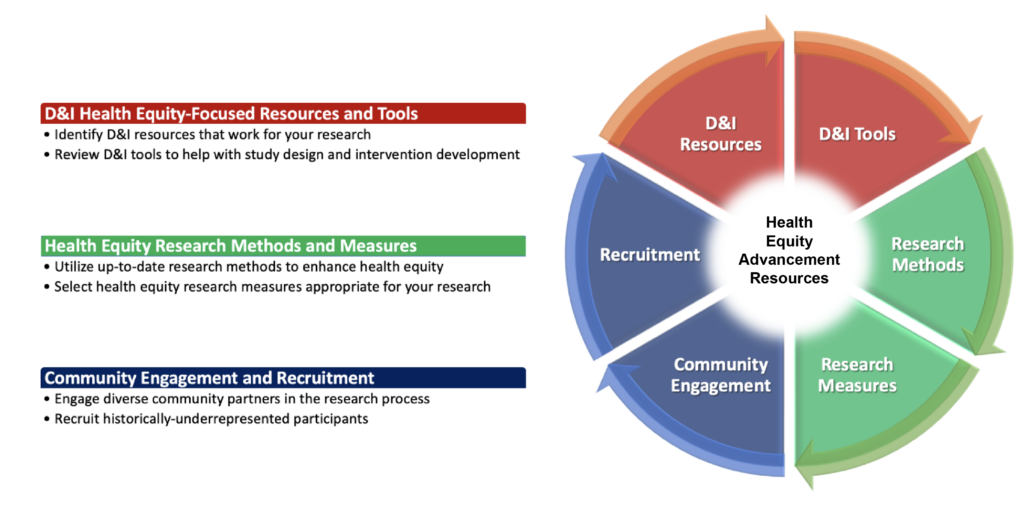Learn methods to integrate health equity into design of health-related interventions.
Our vision is to provide resources to those who conduct community-based and inclusive research to help them develop, test, disseminate, implement, and sustain health interventions that enhance health and reduce health disparities in collaboration with community partners.

D&I Health-Equity Focused Resources & Tools
Extension of RE-AIM to Enhance Sustainability: Addressing Dynamic Context and Promoting Health Equity Over Time. (Shelton et al., 2020) Provides concrete recommendations for incorporating health equity into RE-AIM framework (Reach, Effectiveness, Adoption, Implementation, Maintenance) and integrates longer-term intervention sustainability; easy to use, adaptable, and clear guidance from top researchers in field.
Addressing Health Disparities through Implementation Science—a need to Integrate an Equity Lens from the Outset. (Kerkhoff et al., 2022) To reduce disparities in health, it is crucial that an equity lens is integrated from the earliest stages of the implementation process. This paper outlines four key pre-implementation steps to consider that may help guide selection and design of interventions and associated implementation strategies that are most likely to be effective in reducing health disparities among vulnerable persons and communities.
Applying an Equity Lens to Assess Context and Implementation in Public Health and Health Services Research and Practice Using the PRISM Framework. (Fort et al., 2023) PRISM (Practical, Robust Implementation and Sustainability Model), the contextual expansion of the RE-AIM (Reach, Effectiveness, Adoption, Implementation, Maintenance) framework has several elements that address health equity, but these have not been explicated, integrated, or illustrated in one place. This article offers guidance for applying PRISM with an equity lens across its four context domains (external environment; multi-level perspectives on the intervention; characteristics of implementers and intended audience; and the implementation and sustainability infrastructure)—as well as the five RE-AIM outcome dimensions.
Translation Planning Tool. This tool assists investigators to identify and determine how and why to engage stakeholders relevant to planning for equitable translation of an intervention into practice. Researchers can add to and edit the planning document over time as they learn more about translation of the intervention/innovation. Note: if research relates to dissemination only, refer to Dissemination Planning Tool.
Dissemination Planning Tool. This tool helps investigators plan for dissemination of their research findings and information to community, practice, and academic audiences, organizations and individuals who can use the information. It is applicable to all phases of research to help plan for dissemination.
Directing Research Toward Health Equity: A Health Equity Research Impact Assessment. Research stakeholders need practical tools to help review and examine any given study’s impact on health equity. This article describes health equity research impact assessment and how it may be used by research reviewers, researchers, academic institutions, and funding agencies to elevate health equity in medical science.
An Implementation Scientist’s Toolkit for Getting Started with Health Equity-Focused Implementation Research. Provides a comprehensive resource to help implementation scientists get started with health equity-focused implementation research. The toolkit assumes that the user has basic knowledge of foundational concepts and constructs in implementation science and is looking for guidance or suggestions regarding what to know, what to consider, and how to start implementation research projects that integrate a health equity lens.
Research Methods & Measures
Updated Guidance on the Reporting of Race and Ethnicity in Medical and Science Journal. Clear guidance that is now part of the AMA Manual of Style on how to report race and ethnicity in medical research and how to frame the discussion to include factors such as social determinants and racism as contributors to any reported inequities.
Transcreation: an implementation science framework for community-engaged behavioral interventions to reduce health disparities. Frameworks for translating evidence-based behavioral interventions into real-world settings seldom account for the special issues in reaching health disparity populations. This article describes a “transcreational” model for designing and delivering interventions to reduce health disparities that accounts for processes of planning, delivering, and evaluating interventions so that they resonate with the community experiencing health disparities.
The PhenX Social Determinants of Health Assessments Collection. This collection is a set of standard data collection protocols that allow researchers to select measures for use in their own research and compare data from different studies.
Community Engagement & Recruitment
How to Embed a Racial and Equity Perspective in Research. Racial and ethnic disparities are evident across a wide range of child and youth indicators. In this community engagement resource, the nation’s leading research organization focused on improving the lives of children and youth, Child Trends, outlines how to be intentional and skillful in incorporating a racial and ethnic equity perspective across research.
ARCC Anti-Racist Reflective Practice Tool. This tool developed by the Alliance for Research in Chicagoland Communities (ARCC) at Northwestern University aims to support researchers and community-academic research partnerships in learning and implementing strategies to integrate racial equity and anti-racism into their partnerships and research design, conduct, leadership, and impact.
ARCC Anti-Racist Reflective PowerPoint. This PowerPoint contains background and reflection questions for academic researchers to consider when forming and building research partnerships with community members and organizations.
Community Health Assessment and Community Health Improvement Plan Resources. This tool offers Community Health Assessment and Community Health Improvement Plan resources relevant for health equity promotion work in Wisconsin.
Points to Consider about Recruitment and Retention While Preparing a Clinical Research Study. This website covers a broad list of 15 topics related to recruitment and retention, most of which should be considered in the early stages of project planning. Note that this information is intended to provide opportunity for research team discussion and consideration. This is not a checklist of items to do to be successful—therefore, the topics are covered superficially for further discussion and examination by your team.
“There’s not much we can do… ”: Researcher-level barriers to the inclusion of underrepresented participants in translational research. This article emphasizes a lack of diversity in health research, exploring both barriers to ameliorating this disparity and the continued importance of implementing strategies to reverse it. It is an in-depth discussion into the effects of systemic racism in health research.